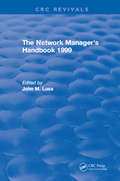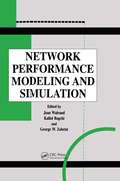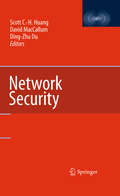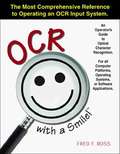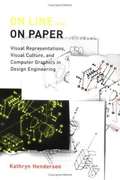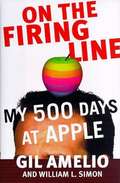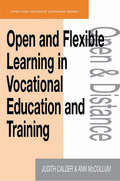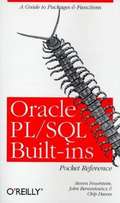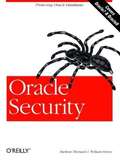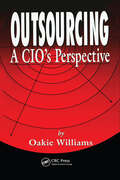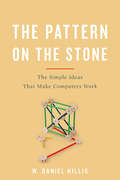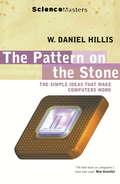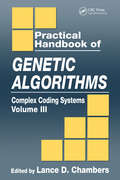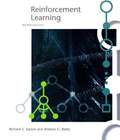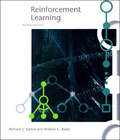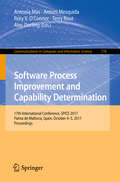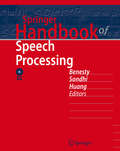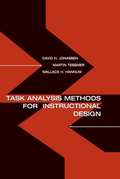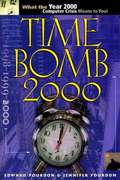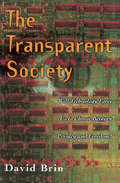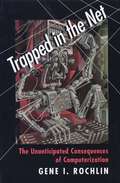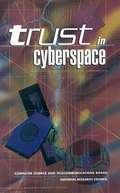- Table View
- List View
The Network Manager's Handbook: 1999 (Auerbach Best Practices In It Ser.)
by John LusaThis essential handbook for the data communications/network manager and planner covers a variety of data communication and IS topics. The Network Manager's Handbook addresses technical issues associated with local and wide area networking, purchasing communications services, supporting the network's users, understanding the telecommunications regulatory environment, personnel issues, and more.
Network Performance Modeling and Simulation
by Jean Walrand Kallol Bagchi George W. ZobristThis book makes the argument that performance modeling and simulation have become central issues in computer science and engineering, in part due to applications to the structures comprising the Internet. Dealing primarily with theory, tools and techniques as related to communications systems, the volume provides tutorials and surveys and relates new important research results. Each chapter presents background information, describes and analyzes important work done in the field and provides direction to the reader on future work and further readings. The topics covered include traffic models for A TM networks, simulation environments, analytical methods, interprocessor communications, and an evaluation of process architectures.
Network Security
by Ding-Zhu Du Scott C.-H. Huang David MaccallumThis book provides a reference tool for the increasing number of scientists whose research is more or less involved in network security. Coverage includes network design and modeling, network management, data management, security and applications.
OCR with a Smile!: An Operator's Guide to Optical Character Recognition
by Fred F. RossThis informative and easy to read book explains OCR as well as problems and fixes that might arise in the process.
On Line and on Paper: Visual Representations, Visual Culture, and Computer Graphics in Design Engineering
by Kathryn HendersonHenderson offers a new perspective on this topic by exploring the impact of computer graphic systems on the visual culture of engineering design. He shows how designers use drawings both to organize work and knowledge and to recruit and organize resources.
On the Firing Line: My 500 Days at Apple
by William L. Simon Gil AmelioFormer CEO of Apple Computer Gil Amelio, who was replaced by Steve Jobs in the summer of 1997, now chronicles his 17 months as head of Apple and reveals the inner workings of a company shrouded in myth and mystery. "On the Firing Line" is Gil Amelio's Up Close and Personal story that dares to unmask the personalities behind Apple Computer and lay bare the facts Apple fans don't know. It untangles the issues involved in Apple's desperate search for a CEO, describes how Steve Jobs claimed that Amelio was the only one who could save the company, and then shows how Jobs played a critical role in manipulating the board of directors to fire Amelio. In an engaging style, Amelio explores many of the problems he confronted as CEO and reveals how he constantly suffered a culture clash with the company and its people -- a clash he describes in terms of Brioni suits and oxfords meeting Levi's "TM" and Birkenstocks. A must-have for every Apple fan and computer world aficionado, this candid, often startling book takes readers inside the boardrooms and computer labs to reveal the way things really are at the company that has become an American icon.
Open and Flexible Learning in Vocational Education and Training (Open and Flexible Learning Series)
by Judith Calder Ann McCollumThis text reviews the strategies adopted in a range of behaviourist approaches to the setting and realization of standards - identifying the background from which they emerged and ways in which they might be further developed.
Oracle PL/SQL Built-ins Pocket Reference
by John Beresniewicz Chip Dawes Steven FeuersteinThis companion quick reference to Steven Feuerstein's bestselling Oracle PL/SQL Programming and Oracle Built-in Packages will help you use Oracle's extensive set of built-in functions and packages, including those new to Oracle8. You'll learn how to call numeric, character, date, conversion, large object (LOB), and miscellaneous functions, as well as packages like DBMS_SQL and DBMS_OUTPUT.
Oracle Security
by William Heney Marlene TheriaultThis book covers the field of Oracle security from simple to complex. It describes basic RDBMS security features (e.g., passwords, profiles, roles, privileges, synonyms) and includes many practical strategies for securing an Oracle system, developing auditing and backup plans, and using the Oracle Enterprise Manager and Oracle Security Server. Also touches on advanced security features, such as encryption, Trusted Oracle, and Internet and Web protection.
Outsourcing: A CIO's Perspective
by Oakie D. WilliamsAs global competition grows more fierce, companies continue to look for ways to increase their competitive edge without jeopardizing profit margins. Today's corporations are starting to realize the competitive advantage that Information Technology (IT) can bring to a company. These corporations are also realizing that staying current with technology requires a great deal of effort, risk, and expense. This is one of the primary reasons CEO's are considering outsourcing as an alternative.Written by a CIO who has successfully maneuvered through the outsourcing process, Outsourcing: A CIO's Perspective addresses the realistic expectations and the most commonly asked questions about IT outsourcing, while reviewing it's advantages and disadvantages. This text identifies key elements that can be used to assess the feasibility of securing a profitable and manageable outsourcing agreement. It provides a convincing case that even if the final decision is to not outsource, the result of the process will identify potential business improvement opportunities.
The Pattern On The Stone: The Simple Ideas That Make Computers Work
by W. Daniel HillisMost people are baffled by how computers work and assume that they will never understand them. What they don’t realize--and what Daniel Hillis’s short book brilliantly demonstrates--is that computers’ seemingly complex operations can be broken down into a few simple parts that perform the same simple procedures over and over again. Computer wizard Hillis offers an easy-to-follow explanation of how data is processed that makes the operations of a computer seem as straightforward as those of a bicycle. Avoiding technobabble or discussions of advanced hardware, the lucid explanations and colorful anecdotes in The Pattern on the Stone go straight to the heart of what computers really do. Hillis proceeds from an outline of basic logic to clear descriptions of programming languages, algorithms, and memory. He then takes readers in simple steps up to the most exciting developments in computing today--quantum computing, parallel computing, neural networks, and self-organizing systems. Written clearly and succinctly by one of the world’s leading computer scientists, The Pattern on the Stone is an indispensable guide to understanding the workings of that most ubiquitous and important of machines: the computer.
The Pattern On The Stone: The Simple Ideas That Make Computers Work (SCIENCE MASTERS)
by Daniel HillisWill computers become thinking machines? A scientist at the cutting-edge of current research gives his provocative analysis.The world was shocked when a computer, Deep Blue defeated Gary Kasparov, arguably the greatest human chess player ever to have lived. This remarkable victory, and other, more day-to-day innovations, beg serious questions: what are the limits of what computers can do? Can they think? Do they learn?Discussions of these questions tend to get muddled because most people have only the vaguest idea of how computers actually work. This book explains the inner workings of computers in a way that does not require a profound knowledge of mathematics nor an understanding of electrical engineering. Starting with an account of how computers are built and why they work, W. Daniel Hillis describes what they can and cannot do - at the present time - before explaining how a computer can surpass its programmer and, finally, where humanity has reached in its quest for a true Thinking Machine.
Practical Handbook of Genetic Algorithms: Complex Coding Systems, Volume III
by Lance D. ChambersPractical Handbook of Genetic Algorithms, Volume 3: Complex Coding Systems contains computer-code examples for the development of genetic algorithm systems - compiling them from an array of practitioners in the field.Each contribution of this singular resource includes:unique code segmentsdocumentationdescripti
Purely Functional Data Structures
by Chris OkasakiMost books on data structures assume an imperative language such as C or C++. However, data structures for these languages do not always translate well to functional languages such as Standard ML, Haskell, or Scheme. This book describes data structures from the point of view of functional languages, with examples, and presents design techniques that allow programmers to develop their own functional data structures. The author includes both classical data structures, such as red-black trees and binomial queues, and a host of new data structures developed exclusively for functional languages. All source code is given in Standard ML and Haskell, and most of the programs are easily adaptable to other functional languages. This handy reference for professional programmers working with functional languages can also be used as a tutorial or for self-study.
Reinforcement Learning: An Introduction
by Richard S. Sutton Andrew G. BartoReinforcement learning, one of the most active research areas in artificial intelligence, is a computational approach to learning whereby an agent tries to maximize the total amount of reward it receives when interacting with a complex, uncertain environment. In Reinforcement Learning, Richard Sutton and Andrew Barto provide a clear and simple account of the key ideas and algorithms of reinforcement learning. Their discussion ranges from the history of the field's intellectual foundations to the most recent developments and applications. The only necessary mathematical background is familiarity with elementary concepts of probability. The book is divided into three parts. Part I defines the reinforcement learning problem in terms of Markov decision processes. Part II provides basic solution methods: dynamic programming, Monte Carlo methods, and temporal-difference learning. Part III presents a unified view of the solution methods and incorporates artificial neural networks, eligibility traces, and planning; the two final chapters present case studies and consider the future of reinforcement learning.
Reinforcement Learning, second edition: An Introduction (Adaptive Computation and Machine Learning series #173)
by Richard S. Sutton Andrew G. BartoRichard Sutton and Andrew Barto provide a clear and simple account of the key ideas and algorithms of reinforcement learning. Their discussion ranges from the history of the field's intellectual foundations to the most recent developments and applications.Reinforcement learning, one of the most active research areas in artificial intelligence, is a computational approach to learning whereby an agent tries to maximize the total amount of reward it receives when interacting with a complex, uncertain environment. In Reinforcement Learning, Richard Sutton and Andrew Barto provide a clear and simple account of the key ideas and algorithms of reinforcement learning. Their discussion ranges from the history of the field's intellectual foundations to the most recent developments and applications. The only necessary mathematical background is familiarity with elementary concepts of probability.The book is divided into three parts. Part I defines the reinforcement learning problem in terms of Markov decision processes. Part II provides basic solution methods: dynamic programming, Monte Carlo methods, and temporal-difference learning. Part III presents a unified view of the solution methods and incorporates artificial neural networks, eligibility traces, and planning; the two final chapters present case studies and consider the future of reinforcement learning.
Software Process Improvement and Capability Determination
by Antonia Mas Antoni Mesquida Rory V. O'Connor Terry Rout Alec DorlingThe SPICE (Software Process Improvement and Capability dEtermination) Project is a joint effort by the ISO and IEC to create an international standard for software process assessment. This book covers both the theory of SPICE and its practical applications, including the lessons learned from the SPICE trials. It includes a valuable automated tool on CD-ROM to help you apply the concepts presented in the book. The text shows the evolution of the most recent developments in the SPICE project. It documents the major products and the empirical evaluations that have been conducted thus far. The book is jointly written by the key experts involved in the SPICE project. The theory chapters describe the rationale behind the architecture and the contents of the V1. 0 and V2. 0 document set and how to interpret them. The remaining chapters describe the applications and how that make use of the theory behind them.
Springer Handbook of Speech Processing
by M. M. Sondhi Jacob Benesty Yiteng HuangThis handbook plays a fundamental role in sustainable progress in speech research and development. With an accessible format and with accompanying DVD-Rom, it targets three categories of readers: graduate students, professors and active researchers in academia, and engineers in industry who need to understand or implement some specific algorithms for their speech-related products. It is a superb source of application-oriented, authoritative and comprehensive information about these technologies, this work combines the established knowledge derived from research in such fast evolving disciplines as Signal Processing and Communications, Acoustics, Computer Science and Linguistics.
Task Analysis Methods for Instructional Design
by David H. Jonassen Martin Tessmer Wallace H. HannumTask Analysis Methods for Instructional Design is a handbook of task analysis and knowledge elicitation methods that can be used for designing direct instruction, performance support, and learner-centered learning environments. To design any kind of instruction, it is necessary to articulate a model of how learners should think and perform. This book provides descriptions and examples of five different kinds of task analysis methods: *job/behavioral analysis; *learning analysis; *cognitive task analysis; *activity-based analysis methods; and *subject matter analysis. Chapters follow a standard format making them useful for reference, instruction, or performance support.
Theories of Programming Languages
by John C. ReynoldsThis textbook is a broad but rigorous survey of the theoretical basis for the design, definition, and implementation of programming languages, and of systems for specifying and proving program behavior. It encompasses imperative and functional programming, as well as the ways of integrating these aspects into more general languages. Basic concepts and their properties are described with mathematical rigor, but the mathematical development is balanced by numerous examples of applications, particularly of program specification and proof, concurrent programming, functional programming (including the use of continuations and lazy evaluation), and type systems (including subtyping, polymorphism, and modularization). Assuming only knowledge of elementary programming, this text is perfect for advanced undergraduate and beginning graduate courses in programming language theory, and will also appeal to researchers and professionals in designing or implementing computer languages.
The Transparent Society: Will Technology Force Us To Choose Between Privacy And Freedom?
by David BrinIn New York and Baltimore, police cameras scan public areas twenty-four hours a day. Huge commercial databases track you finances and sell that information to anyone willing to pay. Host sites on the World Wide Web record every page you view, and "smart" toll roads know where you drive. Every day, new technology nibbles at our privacy.Does that make you nervous? David Brin is worried, but not just about privacy. He fears that society will overreact to these technologies by restricting the flow of information, frantically enforcing a reign of secrecy. Such measures, he warns, won't really preserve our privacy. Governments, the wealthy, criminals, and the techno-elite will still find ways to watch us. But we'll have fewer ways to watch them. We'll lose the key to a free society: accountability.The Transparent Society is a call for "reciprocal transparency." If police cameras watch us, shouldn't we be able to watch police stations? If credit bureaus sell our data, shouldn't we know who buys it? Rather than cling to an illusion of anonymity-a historical anomaly, given our origins in close-knit villages-we should focus on guarding the most important forms of privacy and preserving mutual accountability. The biggest threat to our freedom, Brin warns, is that surveillance technology will be used by too few people, now by too many.A society of glass houses may seem too fragile. Fearing technology-aided crime, governments seek to restrict online anonymity; fearing technology-aided tyranny, citizens call for encrypting all data. Brins shows how, contrary to both approaches, windows offer us much better protection than walls; after all, the strongest deterrent against snooping has always been the fear of being spotted. Furthermore, Brin argues, Western culture now encourages eccentricity-we're programmed to rebel! That gives our society a natural protection against error and wrong-doing, like a body's immune system. But "social T-cells" need openness to spot trouble and get the word out. The Transparent Society is full of such provocative and far-reaching analysis.The inescapable rush of technology is forcing us to make new choices about how we want to live. This daring book reminds us that an open society is more robust and flexible than one where secrecy reigns. In an era of gnat-sized cameras, universal databases, and clothes-penetrating radar, it will be more vital than ever for us to be able to watch the watchers. With reciprocal transparency we can detect dangers early and expose wrong-doers. We can gauge the credibility of pundits and politicians. We can share technological advances and news. But all of these benefits depend on the free, two-way flow of information.
Trapped in the Net: The Unanticipated Consequences of Computerization
by Gene I. RochlinVoice mail. E-mail. Bar codes. Desktops. Laptops. Networks. The Web. In this exciting book, Gene Rochlin takes a closer look at how these familiar and pervasive productions of computerization have become embedded in all our lives, forcing us to narrow the scope of our choices, our modes of control, and our experiences with the real world. Drawing on fascinating narratives from fields that range from military command, air traffic control, and international fund transfers to library cataloging and supermarket checkouts, Rochlin shows that we are rapidly making irreversible and at times harmful changes in our business, social, and personal lives to comply with the formalities and restrictions of information systems. The threat is not the direct one once framed by the idea of insane robots or runaway mainframes usurping human functions for their own purposes, but the gradual loss of control over hardware, software, and function through networks of interconnection and dependence. What Rochlin calls the computer trap has four parts: the lure, the snare, the costs, and the long-term consequences. The lure is obvious: the promise of ever more powerful and adaptable tools with simpler and more human-centered interfaces. The snare is what usually ensues. Once heavily invested in the use of computers to perform central tasks, organizations and individuals alike are committed to new capacities and potentials, whether they eventually find them rewarding or not. The varied costs include a dependency on the manufacturers of hardware and software--and a seemingly pathological scramble to keep up with an incredible rate of sometimes unnecessary technological change. Finally, a lack of redundancy and an incredible speed of response make human intervention or control difficult at best when (and not if) something goes wrong. As Rochlin points out, this is particularly true for those systems whose interconnections and mechanisms are so deeply concealed in the computers that no human being fully understands them.
Trust in Cyberspace
by National Research CouncilWhether or not you use a computer, you probably use a telephone, electric power, and a bank. Although you may not be aware of their presence, networked computer systems are increasingly becoming an integral part of your daily life. Yet, if such systems perform poorly or don't work at all, then they can put life, liberty, and property at tremendous risk. Is the trust that we--as individuals and as a society--are placing in networked computer systems justified? And if it isn't, what can we do to make such systems more trustworthy?This book provides an assessment of the current state of the art procedures for building trustworthy networked information systems. It proposes directions for research in computer and network security, software technology, and system architecture. In addition, the book assesses current technical and market trends in order to better inform public policy as to where progress is likely and where incentives could help. Trust in Cyberspace offers insights into:--The strengths and vulnerabilities of the telephone network and Internet, the two likely building blocks of any networked information system.--The interplay between various dimensions of trustworthiness: environmental disruption, operator error, "buggy" software, and hostile attack.--The implications for trustworthiness of anticipated developments in hardware and software technology, including the consequences of mobile code.--The shifts in security technology and research resulting from replacing centralized mainframes with networks of computers.--The heightened concern for integrity and availability where once only secrecy mattered.--The way in which federal research funding levels and practices have affected the evolution and current state of the science and technology base in this area.You will want to read this book if your life is touched in any way by computers or telecommunications. But then, whose life isn't?
